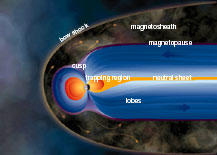ProSEDS May Tie-In to ISS Propulsion
NASA announced that it will begin development of the Propulsive Small Expendable Deployer System, or ProSEDS. ProSEDS will use the Earth's magnetic field to act as a force on a spacecraft, either speeding it up or slowing it down. The system consists of a tether which is lowered into the upper atmosphere. The tether induces a current, which creates an electric field. If the electric field is oriented properly, it will interact with the Earth's magnetic field and act as a force on the system. "This will be a demonstration of a propellant-free propulsion system," said Les Johnson of NASA's Marshall Space Flight Center. ProSEDS will be used as an example of a possible system for use on the International Space Station. The ISS will need periodic orbital reboosts because of slight atmospheric drag. If the tether system works, NASA won't have to worry about the expensive task of bring propellants from Earth to the station.What's New on the Site?
When Nature Strikes - Earthquakes
When Nature Strikes - Volcanoes
When Nature Strikes: Tsunami Classroom Activity
When Nature Strikes: Wildfires - Why are they a challenge to stop?
Windows to the Universe Community | |
News | Opportunities |
You might also be interested in:

Traveling Nitrogen Classroom Activity Kit
Check out our online store - minerals, fossils, books, activities, jewelry, and household items!...more
The Earth's Magnetosphere
The Earth has a magnetic field with north and south poles. The magnetic field of the Earth is enclosed in a region surrounding the Earth called the magnetosphere. As the Earth rotates, its hot core generates...more
1999--A Year in Review...
It was another exciting and frustrating year for the space science program. It seemed that every step forward led to one backwards. Either way, NASA led the way to a great century of discovery. Unfortunately,...more
STS-95 Launch: "Let the wings of Discovery lift us on to the future."
The Space Shuttle Discovery lifted off from Kennedy Space Center at 2:19 p.m. EST, October 29th. The sky was clear and the weather was great as Discovery took 8 1/2 minutes to reach orbit for the Unitied...more
Moon Found Orbiting Asteroid
A moon was discovered orbiting the asteroid, Eugenia. This is only the second time in history that a satellite has been seen circling an asteroid. A special mirror allowed scientists to find the moon...more
U.S. is Fed Up with Russia
Will Russia ever put the service module for the International Space Station in space? NASA officials are demanding an answer from the Russian government. The necessary service module is currently waiting...more
More on Recent Coronal Mass Ejection
During a period of about two days in early May, 1998, the ACE spacecraft was immersed in plasma associated with a coronal mass ejection (CME). The SWICS instrument on ACE, which determines unambiguously...more
Mother Nature's Air Conditioning
J.S. Maini of the Canadian Forest Service has referred to forests as the "heart and lungs of the world." Forests reduce soil erosion, maintain water quality, contribute to atmospheric humidity and cloud...morePlease log in
Science Blogs
Real Climate: climate science from climate scientists

Windows to the Universe, a project of the National Earth Science Teachers Association, is sponsored in part is sponsored in part through grants from federal agencies (NASA and NOAA), and partnerships with affiliated organizations, including the American Geophysical Union, the Howard Hughes Medical Institute, the Earth System Information Partnership, the American Meteorological Society, the National Center for Science Education, and TERC. The American Geophysical Union and the American Geosciences Institute are Windows to the Universe Founding Partners. NESTA welcomes new Institutional Affiliates in support of our ongoing programs, as well as collaborations on new projects. Contact NESTA for more information.





